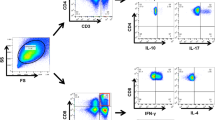Abstract
Although the pathogenetic significance of hepatitis B virus x protein (HBxAg) in chronic hepatitis, liver cirrhosis, and primary hepatocellular carcinoma has already been studied, the comparative analyses of both the actual serum HBxAg levels and antibody production against various HBx epitopes have been examined to lesser extent. We have simultaneously investigated the relationship between antibody production (IgG andIgM) against the HBxAg fragments and HBxAg level in the sera of patients with acute (14) or chronic hepatitis (80) and symptomless carriers (12). A recently developed sandwich-type ELISA was used for the quantitative measurements of HBxAg. Overlapping recombinant and synthetic antigens were used to map the fine epitope specificities of circulating anti-HBx antibodies. In acute hepatitis, we have found high and homogenous correlation in the IgM type immune responses against all the examined HBxAg regions. Moreover, strong correlation has been observed between IgG type immune responses to a characteristic C-terminal region (C1: 79–117) and the longest fragment (X: 10–143). Moderate correlation has been found between HBxAg concentration and the IgG type anti-HBx antibody levels against C-terminus of HBxAg in patients with chronic hepatitis. In the case of symptomless carriers, there were also demonstrable associations in the immune responses against the C-terminal sequences; however, significant correlations were found for antibody production against the N-terminal region as well. The examinations show that the C-terminal sequence, responsible for transactivation, promotes an efficient IgG antibody response in all three groups of patients, whereas the negative regulator N-terminal part of the HBxAg molecule for the most part does not trigger antibody production. This suggests that the immune responses against various — biologically active — epitopes of the HBxAg may have a different role in the pathogenesis of hepatitis and may be used as prognostic markers in human HBV infections.
Similar content being viewed by others

References
Altschul SF, Madden TL, Schaffer AA, et al: “Gapped BLAST andPSI-BLAST: a new generation of protein database search prograins”. Nucleic Acids Res 25: 3389–3402, 1997
Bichko V, Pushko P, Dreilina D, et al: Subtypeayw variant of hepatitis B virus. DNA primary structure analysis. FEBS Lett 185: 208–212, 1985
Caselmann WH: Trans-activation of cellular genes by hepatitis B virus proteins: A possible mechanism of hepatocarcinogenesis. Adv Virus Res 47: 253–302, 1996
Feitelson MA, Clayton MM, Blumberg BS: X antigen/antibody markers in hepadnavirus infections. Presence and significance of the hepadnavirus X gene product(s) in serum. Gastroenterology 98: 1071–1078, 1990
Hann HW, Lee J, Bussard A, et al: Preneoplastic markers of hepatitis B virus-associated hepatocellular carcinoma. Cancer Res 64: 7329–7335, 2004
Hwang GY Lin CY, Huang LM, et al: Detection of the hepatitis B virus X protein (HBx) antigen and anti-HBx antibodies in cases of human hepatocellular carcinoma. J Clin Microbiol 41: 5598–5603, 2003
Jung MC, Sternler M, Weimer T, et al: Immune response of peripheral blood mononuclear cells to HBx-antigen of hepatitis B virus. Hepatology 13: 637–643, 1991
Kumar V, Jayasuryan N, Kumar R: A truncated mutant (residues 58–140) of the hepatitis B virus X protein retains transactivation function. Proc Natl Acad Sci USA 93:5647–5652, 1996
Malik AH, Lee WM: Chronic hepatitis B viras infection: treatment strategies for the next Millennium. Lee Ann Intern Med 132: 723–731, 2000
Marczinovits I, Somogyi C, Patthy A, et al: An alternative purification protocol for producing hepatitis B virus X antigen on a preparative scale in Escherichia coli. J Biotechnol 56: 81–88, 1997
Misra KP, Mukherji A, Kumar V: The conserved amino-teminal region (arnino acids 1–20) of the hepatitis B virus X protein shows a transrepression function. Virus Res 105: 157–165, 2004
Murakami S, Cheong JH, Kaneko S: Human hepatitis virus X gene encodes a regulatory domain that represses transactivation of X protein. J Biol Chem 269: 15118–15123, 1994
Murakami S: Hepatitis B virus X protein. Structure, function and biology. Intervirology 42: 81–99, 2001
Murakami S: Hepatitis B viras X protein: a multifunctional viral regulator. J Gastroenterol 36: 651–660, 1999
Ordog K, Szendroi A, Szarka K, et al: Perinatal and intrafamily transmission of hepatitis B virus in three generations of a low-prevalence population. J Med Virol 70: 194–204, 2003
Pal J, Czompoly T, Nyarady Z, et al: Determination of the fine epitope specificity of an anti-hepatitis B virus X protein monoclonal antibody using microanalytical and molecular biological methods. Mol Immunol 40: 241–246, 2003
Pal J, Palinkas L, Nyarady Z, et al: Sandwich type ELISA and a fluorescent cytometric microbead assay for quantitative determination of Hepatitis B virus X antigen level in human sera. J Immunol Methods, 2005 (accepted for publication)
Pal J, Somogyi C, Szmolenszky AA, et al: Immunohistochemical assessment and prognostic value of hepatitis B virus X protein in chronic hepatitis and primary hepatocellular carcinomas using anti-HBxAg monoclonal antibody. Pathol Oncol Res 7: 178–184, 2001
Song CZ, Wang QW,Song CC, Bai ZL: Viral replication modulated by synthetic peptide derived from hepatitis B virus X protein. World J Gastroenterol 10: 389–392, 2004
Stemler M, Weimer T, Tu ZX, et al: Mapping of B-cell epitopes of the human hepatitis B vims X protein. J Virol 64: 2802–2809, 1990
Tiollais P, Pourcel C, Dejan A: The hepatitis B virus. Nature 317: 489–495, 1985
Author information
Authors and Affiliations
Corresponding author
Rights and permissions
About this article
Cite this article
Pál, J., Nyárády, Z., Marczinovits, I. et al. Comprehensive regression analysis of hepatitis B virus × antigen level and anti-HBx antibody titer in the sera of patients with HBV infection. Pathol. Oncol. Res. 12, 34–40 (2006). https://doi.org/10.1007/BF02893429
Received:
Accepted:
Issue Date:
DOI: https://doi.org/10.1007/BF02893429



